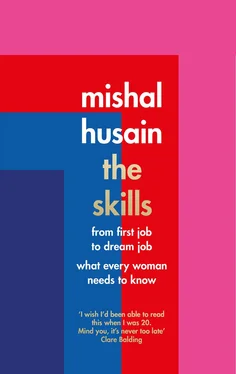Camille Paglia
If I feel fortunate to have been born in a time when my opportunities have been so much greater than my mother’s, it is also true that the advancement of women has not reached the point I would have imagined it might when I left university in 1995. By then, both the UK and my parents’ country of origin, Pakistan, had elected female prime ministers and, if asked, I would have said that spoke volumes about change and progress.
More than twenty years on, I now see that while we owe a great deal to those who smashed glass ceilings and led the way, the follow-up – assuming there is one – is vital. It was Norway’s Erna Solberg, the second woman to be elected prime minister of her country, who brought this home when she told me why she likes the ‘second woman’ role: ‘It means the first was not a one-off.’ Even her country, known for being one of the most gender-equal in the world, has not reached a fifty-fifty split in Parliament – although with 41 per cent women, it is still doing better than most. 1In India, women make up only 12 per cent of the Lok Sabha, or lower house of Parliament, while in China a woman has never sat on the Communist Party’s most powerful decision-making body, the Politburo Standing Committee. 2
Interestingly, the picture for Chinese business is considerably better, with women holding 31 per cent of senior leadership roles. It’s a proportion matched in Africa and exceeded in Eastern Europe, but in businesses in the European Union, women hold 27 per cent of senior roles and in North America, just 21 per cent. 3The study, by the accountants Grant Thornton International, noted that those countries with the most policies in place to promote equality – equal pay, parental leave, flexible working – were not necessarily those with the greatest diversity at the top of business. Policy alone was not producing large scale change, they said, while stereotypes about gender roles were still a barrier to progress. That is a conclusion that perhaps makes clearer where the focus for my generation and younger women should lie – we need to think about individuals as well as institutions.
We can take heart, however, from studies that have compared companies’ records on diversity and their performance – one analysis of more than 20,000 firms in 91 countries found that the presence of women in corporate leadership correlated positively with profitability. 4Another, from consultants at McKinsey, reported that a correlation between gender and ethnic diversity and financial performance generally holds true across geographies. While they couldn’t say that one caused the other, they observed a ‘real relationship between diversity and performance’ and said the reasons for it would include ‘improved access to talent, enhanced decision making and depth of consumer insight and strengthened employee engagement and licence to operate’. 5
A broad perspective on where there’s been progress – and where there are gaps – comes from the World Economic Forum’s annual analysis of gender-based disparities. In 2017, it reported that the 144 countries studied had made great strides in two key areas – health and educational attainment. The major gaps lay in two others – political empowerment and economic participation and opportunity – with particular concern that the average earnings of men were rising faster than those of women. 6It also highlighted how women are likely to be affected by key future trends: automation will significantly affect industries in which many are currently employed, and they are under-represented in high-income and high-growth fields such as technology and science. Even countries where women have made great strides cannot be assured of future progress, explains the organisation’s head of education, gender and work, Saadia Zahidi: ‘A lot of advanced economies have stalled as they were riding the wave of the education boom among women, but if the responsibility of home and childcare is still on those women, there is a limit to how much they can do in the workplace.’ 7
In India the growth in girls’ education hasn’t resulted in women entering the workforce in the numbers you might expect or hope for, especially in a growing economy. In fact, according to the Harvard economist Professor Rohini Pande, female participation in the Indian labour market has been falling, down from 37 per cent to 28 per cent between 1990 and 2015. It’s not a lack of political will to get more women into paid employment, she says, or a lack of interest from women themselves. Instead, there is a significant role being played by social norms – among parents, husbands and parents-in-law – about appropriate behaviour for women. Pande’s research also suggests that while low pay is the main reason for Indian men to leave a job or not accept one, women cite family pressures and responsibilities. 8
Those pressures might relate to taking care of the household, but also basic mobility – requiring permission to go out, for example. As Professor Pande says: ‘It’s pretty difficult to look for a job if you can’t leave the house alone.’ Even in India’s urban areas, she and her associate Charity Troyer Moore found female workers struggling to access male-dominated networks. ‘Women often end up in lower-paid and less-responsible positions than their abilities would otherwise allow,’ they say, ‘which, in turn, makes it less likely that they will choose to work at all, especially as household incomes rise and they don’t absolutely have to work to survive.’ 9
Nonetheless, the experience of a country like Bangladesh, with similar social and cultural norms to India, shows that there are ways such barriers can be tackled. It has a higher proportion of working women than India, largely thanks to the development of its garment industry, where 80 per cent of the workers are female. On a trip there in 2015, I saw for myself the difference that a job in one of these factories can make to an individual’s life. In a room packed with rows of women at sewing machines, one young worker’s ID card, hanging around her neck, bore the photograph of a young boy on the reverse. She was a widow and this was her only child. His future was her biggest motivation and she was able to pay for his education thanks to her job – without it, they would both be dependent on the mercy of relatives. Indeed, Pande and Moore say the garment sector has been important for Bangladeshi women’s empowerment far beyond the factory floor: ‘The explosive growth of that industry during the last thirty years caused a surge in large-scale female labour force participation. It also delayed marriage age and caused parents to invest more in their daughters’ education.’ 10
In the UK much of the conversation about the workplace gaps remaining between men and women has focused on pay, largely due to a 2017 law requiring larger employers to reveal the difference in the mean and median pay of their male and female workers. Because gender pay reporting is based on averages it is in some ways a crude calculation – the airline easyJet, for example, reported a particularly large gap because men dominate its cohort of pilots, who are paid considerably more than the mostly female cabin crew.
The system does, however, lead to questions being asked about how women might be better represented among the higher-paid roles, which is why the director-general of the Confederation of British Industry, Carolyn Fairbairn, welcomes it: ‘This is about fairness but it’s also about productivity in our economy and how we have businesses that have all the talents. We do not have enough women who are pilots, or CEOs who are women, or enough top senior consultants in hospitals who are women. These are issues that we now need to really grip.’ 11Others believe the obligation to report has transformed companies’ conversations about gender. ‘When we’ve talked about the pay gap before, the response has always been “That must be happening somewhere else”,’ says Ann Francke of the Chartered Management Institute. Now, she says companies are being forced to confront their data and reflect on the picture it paints. 12
Читать дальше












